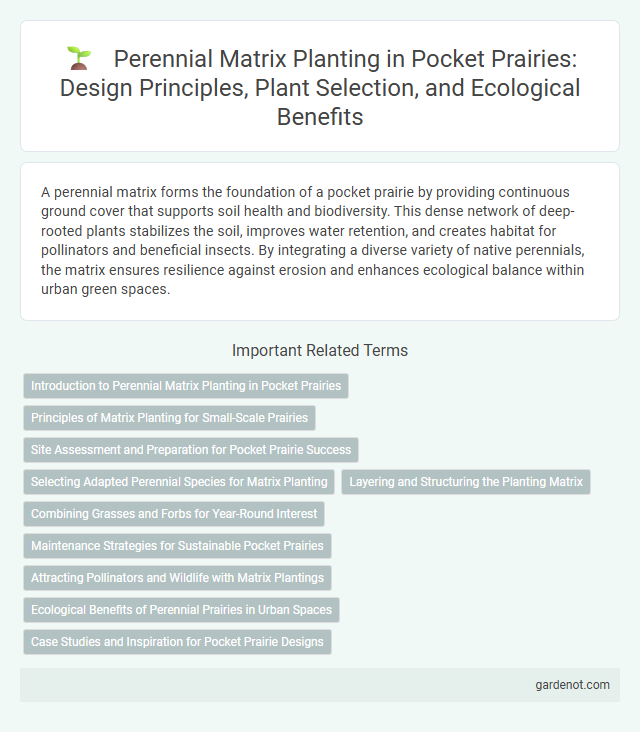A perennial matrix forms the foundation of a pocket prairie by providing continuous ground cover that supports soil health and biodiversity. This dense network of deep-rooted plants stabilizes the soil, improves water retention, and creates habitat for pollinators and beneficial insects. By integrating a diverse variety of native perennials, the matrix ensures resilience against erosion and enhances ecological balance within urban green spaces.
Introduction to Perennial Matrix Planting in Pocket Prairies
Perennial matrix planting in pocket prairies creates a resilient and sustainable ecosystem by incorporating diverse, deep-rooted plant species that promote soil health and biodiversity. These perennial plants establish stable root networks that improve water infiltration and reduce erosion, enhancing the overall ecosystem function. Integrating a carefully selected mix of native grasses and forbs in the planting matrix supports pollinators and wildlife, fostering ecological balance within urban or small-scale prairie restorations.
Principles of Matrix Planting for Small-Scale Prairies
Matrix planting in small-scale pocket prairies emphasizes species diversity and spatial arrangement to create resilient perennial systems. Key principles include selecting complementary species with varying heights, root depths, and bloom times to enhance niche differentiation and resource use efficiency. Establishing a dense matrix reduces weed invasion, supports beneficial insects, and promotes soil health through continuous coverage and nutrient cycling.
Site Assessment and Preparation for Pocket Prairie Success
Site assessment for pocket prairie success involves detailed soil analysis, evaluating native plant compatibility, and understanding local climate conditions to ensure a resilient perennial matrix. Proper site preparation includes removing invasive species, optimizing soil structure through minimal tilling, and incorporating organic matter to enhance nutrient availability. These steps create an ideal environment for deep-rooted perennials to establish robust growth, improve biodiversity, and increase ecosystem stability.
Selecting Adapted Perennial Species for Matrix Planting
Selecting adapted perennial species for a pocket prairie's perennial matrix involves prioritizing native plants that thrive in local soil and climate conditions, enhancing biodiversity and ecosystem stability. Key species often include deep-rooted grasses like little bluestem (Schizachyrium scoparium) and forbs such as purple coneflower (Echinacea purpurea), which promote soil health and provide wildlife habitat. Successful matrix planting focuses on species with complementary growth habits and flowering times to maintain year-round structure and ecological function.
Layering and Structuring the Planting Matrix
A perennial matrix in pocket prairies is designed by layering diverse plant species with varying heights, root depths, and growth forms to enhance ecosystem function and resilience. Structuring the planting matrix ensures optimal resource use, promotes soil health, and supports pollinator habitats by creating microclimates and stratified vegetation layers. This approach maximizes biodiversity while stabilizing soil and improving water infiltration through complementary root systems.
Combining Grasses and Forbs for Year-Round Interest
A perennial matrix combining diverse native grasses and forbs creates a resilient pocket prairie that offers continuous seasonal interest and habitat value. Selecting species with staggered bloom times and varying heights ensures dynamic visual texture and supports pollinators throughout the year. This strategic mix enhances soil health, reduces erosion, and fosters biodiversity in urban and rural landscapes.
Maintenance Strategies for Sustainable Pocket Prairies
Perennial matrix maintenance in sustainable pocket prairies involves targeted mowing, controlled burns, and selective weeding to promote native species diversity and suppress invasive plants. Soil health monitoring and adaptive irrigation optimize plant resilience and water use efficiency within these ecosystems. Integrating periodic assessments ensures ecological balance and long-term habitat functionality in urban green spaces.
Attracting Pollinators and Wildlife with Matrix Plantings
Perennial matrix plantings create dense, diverse habitats that attract a wide range of pollinators such as bees, butterflies, and hummingbirds essential for ecosystem health. These plantings provide continuous bloom periods and varied floral resources, supporting wildlife throughout the growing season. Incorporating native perennials enhances biodiversity by offering shelter and food sources for beneficial insects, birds, and small mammals in pocket prairies.
Ecological Benefits of Perennial Prairies in Urban Spaces
Perennial matrices in pocket prairies enhance urban biodiversity by providing habitat and food sources for pollinators, birds, and beneficial insects throughout the year. These deep-rooted perennial plants improve soil health by increasing organic matter, reducing erosion, and enhancing water infiltration, which mitigates stormwater runoff and urban flooding. Perennial prairies also sequester carbon effectively, contributing to urban climate resilience and improving air quality by filtering pollutants.
Case Studies and Inspiration for Pocket Prairie Designs
The perennial matrix in pocket prairie designs fosters biodiversity by incorporating native grasses, flowering perennials, and legumes that enhance soil health and support pollinators. Case studies in the Midwest demonstrate significant increases in insect populations and improved water retention when diverse perennial species are integrated thoughtfully. Inspiration from successful pocket prairie projects highlights the importance of selecting regionally adapted plants and structuring layers that balance aesthetics with ecological function.
Perennial matrix Infographic

 gardenot.com
gardenot.com